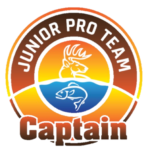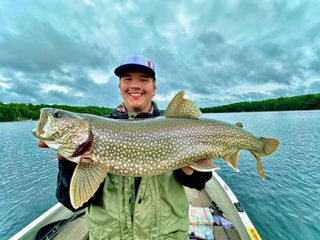By Outdoor News Junior Pro Team Captain Ronny Hustvedt

In my opinion, lake trout are one of the tastiest fish to swim the waters of the region around the Great Lakes, and they are one of the best fighting fish. As tasty as they are, lake trout can be fussy eaters in the summertime and fishing for them can test an angler’s patience.
Hook up with one, however, and you’ll be hooked. Especially if you love the taste of fish.
Lake trout can be found in all five Great Lakes but I’m going focus on the hundreds of inland lakes that hold lake trout and can be caught with a regular fishing boat or even self-propelled boat like a rowboat, canoe or kayak.
Research and planning
The best way to begin is find a lake trout lake near you or that you are willing to travel to. You need a deep, clear, clean, well-oxygenated lake. Because they can be so difficult to catch in the summertime, you want to spend time doing your homework and scouting through lake reports, fishing reports and contacting bait shops.
Most states of the Great Lakes region have listings of designated lake trout lakes on the DNR website or the fishing regulations. That’s a good place to start. I like fishing in the Boundary Waters Canoe Area Wilderness of Minnesota and some lakes in Michigan’s upper peninsula. Wisconsin, Pennsylvania and New York all have great places to try as well.
What lake trout eat
Lake trout are most hungry at dawn and dusk and prefer live bait most of the time. They are known to eat tulibee, sucker, whitefish, shiners and freshwater shrimp. Livebait is tough to keep fresh in the summertime, however, but I like using smelt I buy frozen from the baitshop. I also go sucker fishing in the spring and freeze some of the fillets. Sliced chunks of those on a big jig work well.
Live bait can be tough to find sometimes, and even tougher to keep fresh in the summer heat, so trolling lures is usually the easiest and will work well in a motorized or non-motorized boat. You can vertical jig as well with a heavy jig in the one to two ounce range and a white or glow in the dark twister tail grub (or any color you want).
Find the best place
Once you select your lake, take a look at a lake map and search for the deepest water and the places where there are steep drop-offs into that basin. I really like when there are sunken islands (reefs) and underwater points.
If you have access to electronics, use those to try and determine how far down the lake trout are holding. If you don’t have that, you can use weights and change your trolling speed to keep a lure down far enough. Anywhere from 35 to 65 feet down is a good target range if you are guessing.
Lake trout lures
My favorite lures to troll are silver colored crankbaits that I get deep using a dipsy-diver or weight. Flashy spoons are also good or inline spinners.
Make sure you have a good net along with because once you hook one they have a tendency to swim with the lure—until they see the boat. Then that lake trout can take some wild runs and peel off tons of line. You want to net it sooner than later so you can take some great pictures and decide if you are going to keep it or not.
Hooked on lake trout
If you keep it, be sure to keep it cold or alive as long as possible. Because there are so many nutritious fats in the meat it needs to be cleaned pretty quick. I like to fillet my lake trout and then grill it skin-side down with spices and a little flavored olive oil on the top. Baked lake trout is also delicious with melted butter drizzled on top.
Catch one and eat it, and you will be obsessed with catching more just like I have become the past few years. Keep trying until you figure it out and then don’t expect to catch one every time—that’s why they call it fishing, not catching, right?


